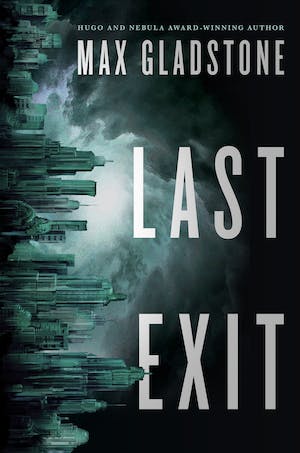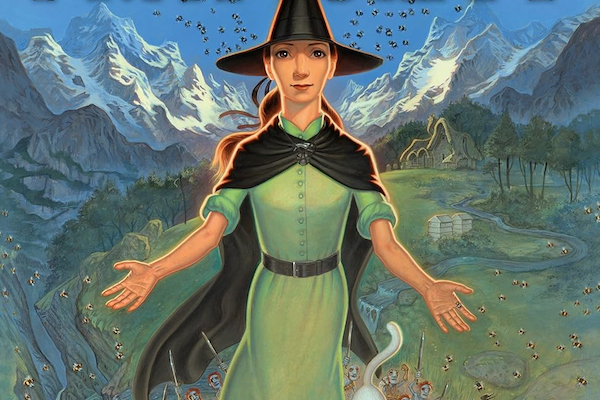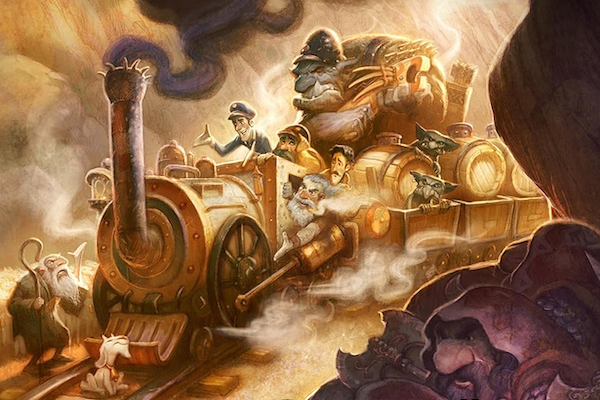Welcome back to Reading the Weird, in which we get girl cooties all over weird fiction, cosmic horror, and Lovecraftiana—from its historical roots through its most recent branches.
This week, we start on the first two chapters of Max Gladstone’s Last Exit. The novel was first published in 2022. Spoilers ahead!
Summary
“She was coming home as the end of the world.”
Ten years ago, Zelda returned to Ma Tempest’s home in the Bronx to apologize and atone for losing Sal, Ma’s favorite and first-born. After she pounded her knuckles bloody on the olive-colored door, Sal’s six-year-old cousin June opened up to say Ma didn’t want to talk to her. Every year since, on Sal’s birthday, Zelda’s made the pilgrimage of contrition, and been denied entry.
It wasn’t supposed to end this way. College taught her class that they’d save the world, “seize its reins and turn it toward truth and light.” Zelda, her lover Sal, and friends Sarah, Ramon and Ish took to the road in Ramon’s black Challenger, armed with mathematics, strange physics and “the deeper dream logic of chance, memory and regret.” Powered by energy called “spin,” they slipped through the “alts” in search of a better reality. Instead they found only broken worlds. There’s an edge beyond human imagination; past that edge lives something old, hungry to invade and corrupt. Humanity’s reality is yet unfallen to this “rot,” but its walls weaken. The friends sought “a crossroads, far out in the alts,” where worlds meet; there they hoped to fix everything.
They failed. Zelda couldn’t save Sal from “whip-like legs of shadow” that altered her into a creature of mad laughter, of tongues and fangs, of blade-claws that tore Zelda’s arms before Sal fell into “the rotten places” where “angles don’t meet like angles should” and where “alive” and “dead” have no meaning. Sarah, Ramon and Ish deserted Zelda, leaving her to hitch-hike to Ma Tempest’s first rejection.
At first Zelda hoped that if she “went far enough, fast enough” she’d find Sal, but her efforts worsened everything. Nowadays she can only combat the rot’s assaults on our reality, while new cracks form before she can fix the old. She travels alone, increasingly scarred, living in her hard-used Subaru and working dead-end jobs. On a rot-hunt in Tennessee, she destroys a fledgling corruption nourished by an abused wife’s need for a “listener.” The woman curses her for killing the thing that would soon devour her.
Buy the Book


Last Exit
In flashback, child Zelda endures an epic mountain search for the corpse of her (cougar?)-slain dog, Goof; the reek of his decay remains her way of perceiving cosmic corruption. In flashback, Yale freshman Zelda meets Sal, who rescues her from a Christian Fellowship meeting. They share their first kiss on a campus rooftop.
From Tennessee, Zelda rushes to the Bronx for her annual vigil. This time sixteen-year-old June opens the door, looking heart-wrenchingly like Sal. Ma’s not home, June says, and she demands to “know everything” that happened to Sal. They walk together. June knows that Sal and her college friends used magic to “go places.” Sal would bring home gifts, like the 1980s Aztec medallion June still wears. Zelda explains the “magic” is “just… possibilities.” Ways to exploit uncertainty. Zelda figured out the math. Sal suggested the observer-dependency. If there are other possibilities to each observed outcome, where do they go after one possibility manifests? They looked for folds in the world. Then the friends went on “a road trip across…everywhere.”
June’s still angry that Sal chose to leave her and Ma. She demands to learn what made the alts so important to Sal. Zelda hesitates to expose June to danger, but wants to share the truth—why else walk with June to the middle of a bridge over the Hudson, symbolically neither one place or another? So she leads the girl through the process of slipping “in-between.” June, like Sal, always wants to go deeper. They pass through various post-apocalyptic New Yorks to one where huge forms “shambled across the ruins…bleeding ichor” and “wild flutes rose on the wind, shrill and alien”. Clouds stretched “a tongue down toward them, long and black and winding as a road.”
Zelda tells June to stop, but the voice that answers is a hungry, ragged version of Sal’s, the “voice of the edge and the end of the world.” As before, Sal holds Zelda’s wrist in a saw-toothed grip. She has so much to show her.
Zelda breaks free. Sal-June steps off the bridge, and instead of falling, climbs the air toward a cloud of black-lightning eyes. Zelda can’t deprive Ma Tempest of another child; she catches June, dragging her back through the alts to home—and to the rank waters of the Hudson. Panicked, June almost drowns them both, but Zelda manages to get them to shore. June insists Sal isn’t gone forever. She’s coming home, for Zelda, bringing rot in her wake.
June must stay in New York, says Zelda, where the wall between worlds is highest. Zelda has to find the friends who abandoned her. They’ll have to listen, now that Sal is returning “as the end of the world.”
As Zelda’s leaving, June says she saw what was beyond the Sal-storm. It’s what Sal told Zelda ten years before: it’s “beautiful.”
This Week’s Metrics
A Universe Full of Teeth: Gladstone’s universe is literally and linguistically trying to eat you. This week, Zelda first kisses Sal on “a writhing night full of blades and fangs,” a Rot-ridden forest is “a gullet lined with teeth,” and Sal’s Rot-possessed mouth is “many-tongued and fanged.”
What’s Cyclopean: Hunting the Rot, Zelda picks up “a silver ozone smell of sour moonlight.”
The Degenerate Dutch: New York’s solidified misery is typified by its systematic racism: gentrification, neighborhoods broken and parasitized by Robert Moses’s chained roads, areas bereft of playgrounds.
Weirdbuilding: June is an all-too-familiar figure, someone driven to know despite all warnings against the cost of knowing too much. And still she pulls Zelda “tumbling downhill into the weird.” (There are flutes there. There are always flutes.)
Libronomicon: As a child, Zelda brings rope to retrieve her lost dog, following Sam Gamgee’s advice that “We’ll want it if we haven’t got it.” The dog’s corpse comes to mind later when she reads The Brothers Karamazov, in which monks deny the odor of their holy dead Elder Zosima.
Madness Takes Its Toll: The Rot finds cracks where people need something unimaginable, “more than life or sanity.” Sal extols its beauty with a “mad smile.”
Ruthanna’s Commentary
I started reading Last Exit shortly after it came out, and realized two things: (1) it was very, very good, and (2) as with Zelda’s apocalyptic road trip, this was not a journey I could sanely take alone. So I circled back to find appropriate company, and you can now imagine me standing by a beat-up car, holding open the passenger door, urging you to toss your luggage in back and find an open seat. Never mind the scratches on the paint—those are just from branches, no matter how much they look like toothmarks. Come where the map boundaries blur. Come where there are no safe rest stops, but the view of the oncoming apocalypse is absolutely spectacular.
We’ve previously encountered Gladstone warning against the things that sneak into our world through good art. He’s best known for the Craft Sequence, where horrors from beyond reality (out there and coming closer) are leavened by necromantic lawyers, deity-powered heating infrastructure, and train heists. It’s also one of the best explorations of capitalism—and how to outlast it—in modern speculative literature. Last Exit takes on those same themes with the fury and fear turned up to 11. The world is not only dying, but a careless glance reveals it already dead. And unlike the magic-filled world of the Sequence, this is clearly our own world, complete with rising fascism and environmental collapse, “kids in cages and machine gun cops”—and the Rot underneath, embodying the sense that many of us have on our worst days of being surrounded by uncountable existential crises, the inexorable wear of entropy and apocalypse circling with fangs bared. It’s an angry book, with plenty to be angry about.
I sometimes find Lovecraft shockingly optimistic. The Mythos universe is full of life—humans may be trivial, but we aren’t alone. The Outer Ones hint at a cosmos full of company and conversation and wild mystery; the Yith and Elder Things promise an Earth that hosts civilization from the moment the first rocks cool to the day the sun boils the oceans. Humans will survive at least long enough for now-unimagined empires to rise and fall, and after us come the beetle people. Extinction is inevitable, but so are successors, each species learning eagerly and fearfully from the improbably literal bas reliefs created by those who came before. Last Exit turns this on its head. Voltaire was right: we live in the best of all possible worlds. Everywhere else, our world and species have already fallen, and any remaining awareness is driven by hunger rather than curiosity. We are not trivial. For all our helplessness and misery, we’re every chance the universe has beyond the Rot—and it’s coming for us next, driven by that hunger and the vestiges of one human’s love.
Lovecraft’s New York, too, is turned on its head. For Lovecraft, the city was the place of ultimate alienation, where anything was allowed and therefore anything could push through. In Last Exit, New York epitomizes the protective lie of civilization, a place so sure of itself that it grows armor against the inhuman void. Perhaps it’s more akin to Jemisin’s New York, albeit frozen hard rather than living and dynamic. It can keep Cthulhu out, at least for a little while.
One common piece of writing advice is to open the day before everything changes. For Zelda, that change comes when she’s forced out of her self-destructive solitude by finally talking to the family of her long-lost (not dead) lover. She’s been clinging to reality by her fingertips for that chance/obligation—and now that it’s arrived, it brings the admission/revelation that said lover plays a key role in the oncoming destruction. Something has to be done. Cleaning up around the edges, on her own, is no longer enough: it’s time to bring the old gang back together for one last job. With, of course, the inevitable wide-eyed newcomer tagging along.
So it’s a heist, sort of. And a road trip, sort of. And an American gothic, sort of. And cosmic horror in a universe full of teeth and thorns, where you can pull yourself into Schrödinger’s box and peek behind the veil of uncertainty—but may not like what you see there.
Anne’s Commentary
Kander and Ebb’s 1977 anthem tells us that “it’s up to YOU, New York, New York!” Based on our new long-read and N. K. Jemisin’s City We Became, I’d say the success of any one hopeful rube is chopped liver compared to NYC’s true responsibility, which is resisting the invasion of Lovecraftian entities bent on ending our world. Gladstone’s band of Earth-saviors has a wider range than Jemisin’s city-avatars, for their magic isn’t confined within municipal boundaries. It’s a similar magic, however, based on mathematics, quantum physics, and dimension-hopping psychic gymnastics powered by—something. Call it the Force, collective city-energy, or the spin: a hero has to learn how to gather and channel it. Jedi have their masters, city-avatars their city-mentors. So far, Gladstone’s heroes have only their own theoretic musings and hazardous experiments.
I haven’t read ahead in Last Exit, but I’m betting Ma Tempest has had a hand in schooling Sal, Zelda and Company in the more traditional ways of magic. So much the worse for Zelda as the novel opens and Ma closes her out. Convinced that in losing Sal she’s committed a maxima culpa, Zelda doesn’t blame her.
I wonder if Ma’s calculating enough to spurn Zelda’s attempts at apology so that Zelda, unpunished, has no excuse to give up rot-hunting and die. Instead she must punish herself, accumulating scars that aren’t self-inflicted except actually they are, even if by something else’s claws and teeth.
The deepest scars, from a psychological viewpoint, are those that Sal gave Zelda after morphing into a semi-human simulacrum of whatever dragged her into the “infinite pit.” Associated with the Ultimate Other and (presumably) its minions are terror and pain but also exultation. This recalls the “holocaust of ecstasy and freedom” that Lovecraft’s cultists claim will follow Cthulhu’s rising. That madness is the fate of any human touched by Otherness is a universal Mythos concept. That the sound of “wild flutes…shrill and alien” occurs as the “black-flower road” unwinds could indicate that it’s the daemon-sultan Azathoth who hungers beyond the edge of all possibilities, iconically bubbling and blind and mindless, but maybe not in Gladstone’s version, because what Sal and June see over the Edge is “beautiful.”
Not that bubbling-blind-mindlessness couldn’t be aesthetically pleasing, if one put aside human prejudices, a positive side-effect of Edge-awareness? Or not, if such a drastic shift in perception was due to the imposition of an alien mindset. Mindless-set?
But I wander into the kind of theorizing Zelda and friends might have indulged in after a few pulls at Sal’s flask.
Gladstone’s opening chapters are masterful examples of nonlinear exposition. He throws the reader right into story past, not to the actual crucial event which is Sal’s loss but to its crucial—and heartrending—aftermath, Zelda’s first pilgrimage to the Bronx. We don’t learn how Sal was lost until well into Chapter Two, when Zelda gives June a vague account of the event while vividly remembering it herself. But even this vivid memory is brief, centered on the exact moment of the catastrophe, not any before-or-after context that would allow us to judge whether Zelda’s self-blame is justified. Our curiosity has been piqued about Montana, well before we learn that Zelda’s friends abandoned her there. Were they justified in leaving her behind? Bereft of her “listener,” Mona gives Zelda an unanswerable verbal slap: “Just go. Now. I can’t look at you anymore.” Zelda’s heard those words before. From her friends? If so, why? How could she deserve the rejection?
We’re left to find out later. The suspense around Sal’s loss heightens, killing but tantalizing.
Two long flashbacks occur during the build-up to Zelda’s extermination of Mona’s secret rot. The first is her How I Met My Girlfriend story, at a Christian Fellowship mixer no less, from which Sal liberated Zelda before her courageous if maybe ill-timed debut of a rainbow flag pin lands her in trouble. Sal’s catchphrase is “Just a little further,” which she says to Zelda immediately prior to their first kiss. The phrase characterizes Sal to the core; it’s her impulse to take the next step, then the next and the next, that rules her fate for good and bad. She’s been a shadow-presence even before the flashback. It puts her front and center, deepening our understanding of their relationship, hence our sympathy for Zelda’s bereavement, and admiration for her determination to hunt on without Sal and their pack.
If the flashback to Zelda’s recovery of Goof’s corpse served only as an explanation for why she smells the enemy rot as decayed dog, its length would be excessive. However, it also counters the impression created by the first flashback that Zelda is characteristically rather than situationally uncertain and fearful. On familiar ground, with an important job to do, Zelda’s steeliness of spine is exceptional.
So Zelda and Sal have taken on flesh and blood by the end of Chapter Two. June, by virtue of present story-time action, is second only to Zelda. Ramon of the black Challenger has gotten a bit more development than Sarah (she plays guitar) and Ish (it would be a surprise if he—or she—would have called Ma Tempest about Sal.) It’s another sound narrative choice that we’ve yet to meet the three friends in person, and Ma Tempest too.
I’m looking forward to it.
Next week, we belatedly celebrate the recent centennial of Weird Tales with H.G. Wells’s “The Stolen Body, and determine whether to blame him for the depredations of the Yith and/or a century of dubious claims about the pineal gland.












